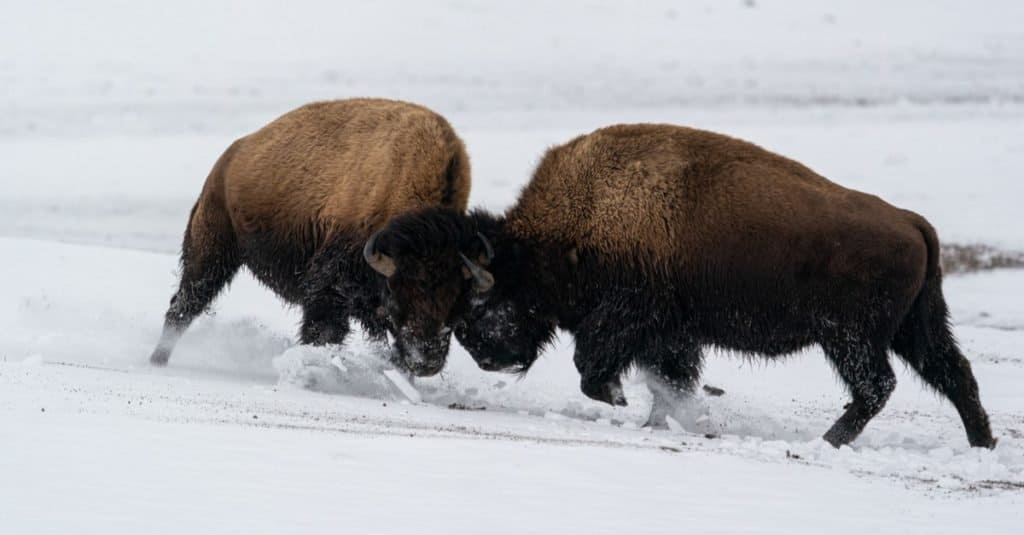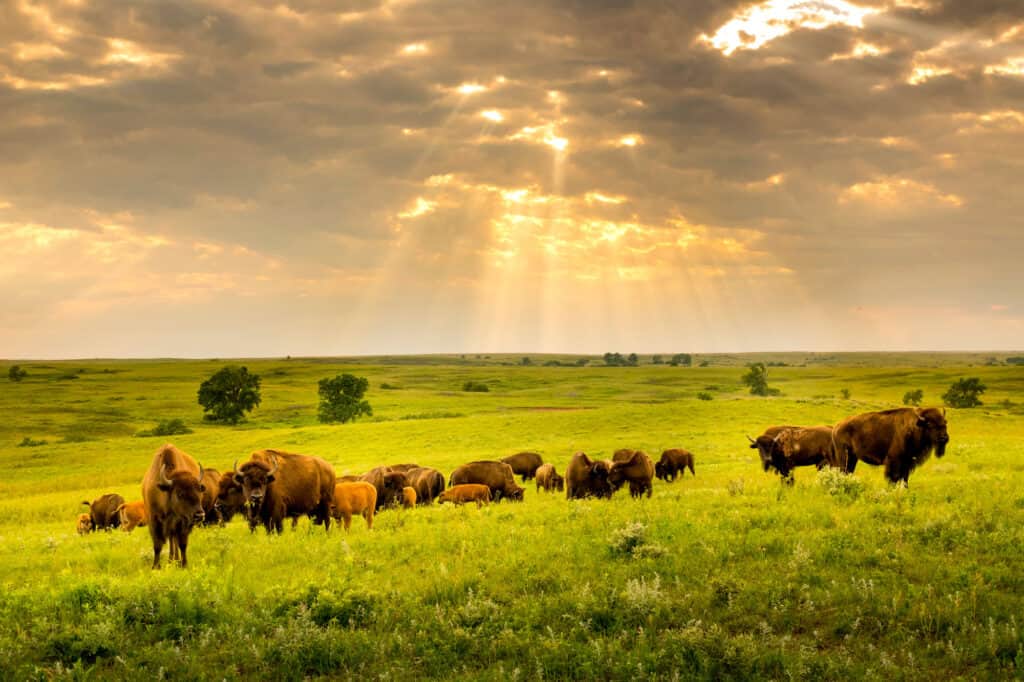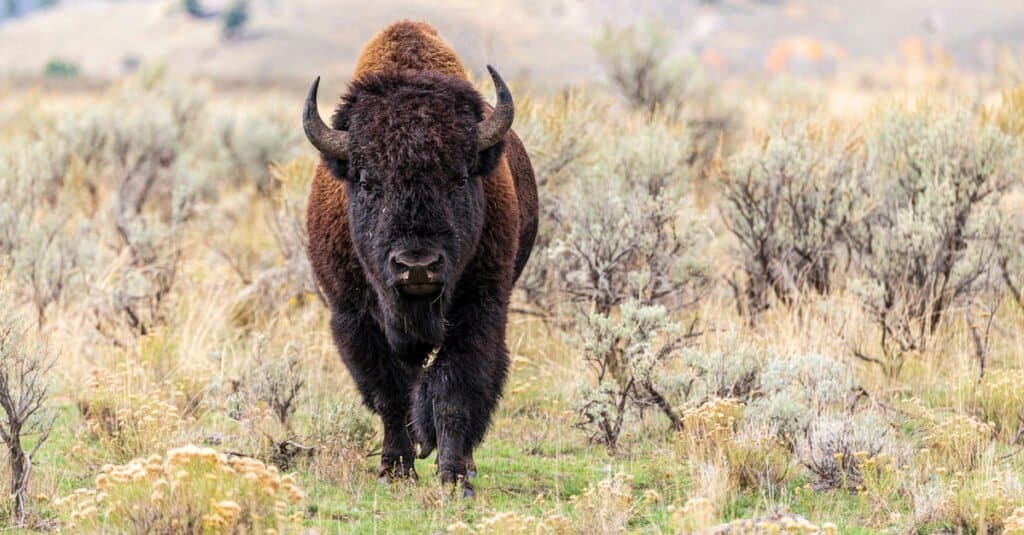Bison, referred to by their scientific name Bison bison, are also called the American buffalo. They belong to the Bovidae family, including domestic sheep, goats, and cattle.
Native to North America, the large shaggy-haired animal is the U.S.’s official mammal.
You can usually distinguish it by its muscle hump and fur, as well as its powerful build and massive size.
Indigenous Americans once considered bison part of their life since they provided shelter, clothing, and food. The iconic animals also had spiritual significance to the Native tribes. But in the late 19th century, the animals were on the verge of extinction due to habitat loss and large-scale hunting. Less than 1,000 animals remained.
Today, bison populations have recovered significantly, and the animal is once again an important symbol of America’s culture and history.
In this article, we discover the largest bison ever caught in Alaska. We also explore the animal’s historical background, commercial exploitation, population and distribution, and conservation efforts.

©massimofusaro/Shutterstock.com
The Largest Bison Ever Caught in Alaska
According to Boone and Crockett Club, the largest bison ever caught in Alaska recorded an impressive score of 126. Walter H. Hammer caught the trophy in 1977, and the records still recognize him as its owner.
Before Hammer’s catch, Alaska’s largest bison catch on record had been one by Mike Stagno, recorded in 1975. Stagno’s trophy recorded a score of 124 4/8. Like Hammer’s catch, Stagno is in the state records as the trophy’s owner.
Historical Background of Bison in Alaska
Bison are iconic animals that once inhabited North America. In Alaska they have a long and fascinating history dating back thousands of years and are strongly connected to the ecosystem and region’s cultural heritage.
Alaskan bison have a complex history that includes both abundance and decline, as well as restoration and conservation efforts.
In Alaska, bison have a long and complicated history dating back thousands of years. They’ve profoundly impacted the state’s history and culture, from their broad presence throughout the Pleistocene era to their decrease due to economic exploitation and the entrance of European settlers.
Bison have inhabited Alaska since the Pleistocene era, about 1.6 million years ago. Their fossils have been discovered throughout Alaska, indicating that animals were widely spread in the state throughout the Pleistocene. Bison and other animals could move between Asia and North America at this time because Alaska was part of the Bering Land Bridge that connected the two continents.
Native Alaskan cultures had deep ties to bison and depended on them for food, tools, and clothes. The tribes would hunt the bison sustainably to ensure their continued survival since they were thoroughly aware of their habits and migration patterns. Many tribes revered the bison as a sacred animal and frequently used them in religious rites and ceremonies.
Impact on Bison Population
European settlers’ arrival in Alaska in the late 19th century significantly impacted the bison population. New hunting tools, including firearms that the settlers brought, made it possible for them to hunt bison on a bigger scale.
Due to commercial hunting for bison’s in-demand meat and hides, their populations rapidly decreased. The Native Alaskan tribes, who depended on the bison for their way of life, were also greatly affected by the reduction in the bison populations.
Smallpox and other non-native diseases were introduced, further contributing to the decline of bison populations and harming the Native Alaskan communities.

©Scalia Media/Shutterstock.com
Commercial Exploitation of Bison in Alaska
Commercial bison harvesting in Alaska had a significant impact on the species as well as the state’s history.
Bison Hunting For Meat and Hides
When European settlers arrived in Alaska in the late 19th century, commercial hunting for bison hides and meat began. That was because Alaska and the 48 lower states had a high demand for bison meat and hides. The meat would be sold in markets, and hides used to make clothing and other products.
The Decline of Bison Populations Due to Commercial Exploitation
Alaskan bison herds were severely impacted by commercial hunting, which sped up their demise. As a result of the rapid decrease, bison in the area were on the verge of extinction by the late 19th century.
Native Alaskan tribes that depended on the bison for their way of life were also significantly impacted by the reduction in their numbers. The decline in bison populations disrupted the Natives’ cultural rituals and traditional hunting practices, contributing to their suffering.
Government Intervention and Conservation Efforts
The U.S. government implemented several conservation measures to safeguard the species in response to the declining bison populations. For example, the government built bison preserves and began to control their hunting.
The conservation initiatives stabilized bison populations and prevented their extinction. But the populations remained thin and not as widespread as before.
Efforts to conserve bison and restore their populations in Alaska have since continued. The new focus is to preserve the animals’ genetic diversity and restore traditional hunting practices for Native Alaskan tribes.
Bison Population and Distribution in Alaska
The bison was once a widespread species in Alaska State. But its populations declined due to habitat loss and commercial hunting.
Current Bison Populations
Currently, the number of bison in Alaska is about 200. They live in a few isolated communities.
Due to their genetic isolation from the bigger populations in the lower states, Alaskan bison have a distinct genetic profile. Conservationists closely monitor this genetic diversity since it’s essential for the species’ long-term survival.
Factors Affecting Bison Populations in Alaska
So, what’s affecting the bison populations in Alaska? There are several factors at play, as we shall find out below.
- Habitat loss and degradation. Because of habitat loss and degradation brought on by human activities like mining and development, bison’s capacity to get the resources they require to thrive may be significantly impacted.
- Climate change. Climate has significantly impacted Alaska, which may affect bison’s food and water supplies.
- Hunting. Because bison are still sought for their meat and hides, hunting is another issue.

©Berns Images/Shutterstock.com
Conservation Efforts for Bison in Alaska
Despite obstacles, conservation efforts are being made to safeguard and preserve Alaska’s bison populations.
Government regulations, policies, and NGOs are all fighting to keep and grow Alaska’s bison population.
Government Policies and Regulations
On the government side, various policies and regulations have been implemented to protect bison populations. For example, laws regulating bison hunting and others limit development in important bison habitats.
Non-Government Organizations
NGOs play a critical role in bison conservation in Alaska. They focus on specific initiatives or programs to help protect bison populations.
For example, there are NGOs working to educate the public about bison and the importance of conservation. Others focus on research and monitoring of bison populations.
One successful example of NGO-led conservation efforts for bison is a program to bring bison back to the Arctic National Wildlife Refuge. The initiative involves working with Native Alaskan communities to re-establish bison populations in Alaska and to promote sustainable hunting practices. In addition, the NGOs work closely with the communities that live and depend on bison to ensure bison’s long-term survival and success.

©Ricardo Reitmeyer/Shutterstock.com
Reintroduction of Bison in Alaska
Bison have been reintroduced into Alaska recently to expand the species’ historical range and support ecological harmony.
The Reintroduction Effort
Various stakeholders have embarked on an elaborate effort to reintroduce bison in Alaska. The stakeholders include:
- Wildlife management
- Conservation organizations
- Regional towns.
It took several years of planning and preparing for the reintroduction. During this time, viable release locations were assessed, and bison supply sources determined.
The bison used for the reintroduction program came from conservation herds in the lower states. The animals underwent stringent inspection to ensure they were disease-free and genetically diverse.
The first bison were released into the Alaskan wilderness in the late 1990s. The goal was to establish a self-sustaining population.
The reintroduction initiative faced various challenges, including:
- Managing the new bison’s interaction with local communities and other wildlife
- Providing adequate water and food
But diligent monitoring and management has enabled the bison population to grow and establish itself in the state.
Impact of Bison Reintroduction
Bison’s reintroduction to Alaska has greatly impacted the ecosystem and the surrounding communities.
As grazing herbivores that can regulate the growth of specific flora, bison play a significant part in preserving the ecosystem’s equilibrium. Additionally, they serve as prey for predators like wolves and bears, and their fecal matter replenishes the soil with vital nutrients.
Additionally, the reintroduction of bison has economically opened up the state’s potential for wildlife tourism. Tourists swarm to Alaska to witness the iconic species in their natural habitat. Similarly, bison meat’s popularity has grown, giving nearby villages a new source of revenue.
For Alaska Natives, who have a long and rich history of coexisting with and using bison, the reintroduction has helped to restore a sense of pride and connection to the land. It has also created new opportunities for cultural and educational experiences, including traditional hunting and management practices.
Controversies and Challenges
Although bison reintroduction to Alaska has had many benefits, several issues have arisen. One of the main worries is the possibility of disease spreading from bison to other wildlife and domestic animals like cattle.
Additionally, there have been confrontations involving local residents, bison, and other wildlife. For instance, bison compete with other grazers for food, and smaller animals may be threatened by their size and aggressive nature.
Finally, there are ongoing debates about managing bison as a potentially invasive species. While native to North America, their reintroduction in Alaska can cause ecological harm if their populations are not properly managed.

©Grey Mountain Photo/Shutterstock.com
Bison Conservation Challenges and Opportunities in Alaska
Bison conservation initiatives have come with both challenges and opportunities, as we shall find out below.
Challenges
Some of the challenges facing bison conservation efforts in Alaska include the following:
- Habitat loss and degradation
- Climate change
- Limited resources for conservation
Habitat loss and degradation is among the biggest challenges facing bison conservation in Alaska. Human activities such as energy extraction, mining, and development can significantly impact bison habitats and the resources that the animals need to survive.
Climate change is another primary concern, as it can affect food and water sources for bison and worsen other threats like disease and predation.
Another challenge is the limited resources available for bison conservation. Government agencies and NGOs often have limited budgets and human resources, making it challenging to effectively protect bison populations and their habitats.
Opportunities
Alaska offers numerous opportunities for bison conservation despite obstacles. Tourism potential is one of these opportunities.
The various stakeholders can generate income from sustainable tourism opportunities such as ecotourism and bison watching. Such funds can be used to support bison conservation efforts.
Collaboration with Native Alaskan tribes, who have a long history with bison, is another opportunity.
Finally, research and monitoring can inform the most effective bison conservation efforts. When the various stakeholders understand bison populations and their habitats, more effective conservation strategies can be developed for any challenges they face.

Key Takeaways
Alaska has a long history with bison, dating back to prehistoric times. Native American tribes depended on them for food and clothing. Besides, they were once a vital part of Alaska’s wildlife. But their populations drastically decreased over time due to overhunting and habitat loss.
Alaska’s bison numbers have started to grow again, thanks to recent reintroduction efforts, although they’re still in danger from diseases and habitat loss.
Despite a recent bison rebound in Alaska, the animals still face numerous dangers, calling for concerted efforts to safeguard and conserve them.
Supporting initiatives to safeguard bison habitats, monitoring their populations, and raising awareness of their significance in Alaska can help achieve this objective.
Up Next
- The 10 Best Fishing Spots in Alaska this Summer
- The 5 Best Places to Camp in Alaska this Summer
- The 15 Deepest Lakes in the United States
The post Discover The Largest Bison Ever Caught in Alaska appeared first on AZ Animals.
from Animal News, Facts, Rankings, and More! - AZ Animals https://ift.tt/Hjh72rL